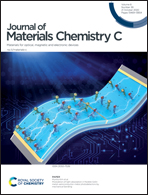Substitutional doped GeSe: tunable oxidative states with strain engineering
Abstract
Layered chalcogenide materials are a wealth of nanoelectronics applications, like resistive switching and energy-harvesting (such as photocatalysis), owing to its electronics, orbitals, and lattice excitations. In this work, we explore monochalcogenide germanium selenide GeSe with respect to substitutional doping with 13 metallic cations by first-principles calculations. Typical dopants, including s-shell (alkali elements Li and Na), p-shell (Al, Pb and Bi), 3d (Fe, Cu, Co and Ni), 4d (Pd and Ag) and 5d (Au and Pt) elements, are systematically examined. Amongst all cationic dopants, Al with highest oxidation states, implying a high mobility driven by the electric field, and Al-doped GeSe may be promising candidates for novel resistive switching devices. We show that many localized induced states exist in the band gap of GeSe on doping with Fe, Co, or Ni. In contrast, for the Cu, Ag, and Au, there is no such state in the gap. Ag and Cu have +0.27 and +0.35 charges respectively, and the positive charges are beneficial for the field-driven motion in GeSe. In contrast, Au is slightly negatively charged, which renders the Au-doped GeSe as a promising photocatalyst and enhanced surface plasmon. Moreover, we explore the coexistence of the dopant and strain in GeSe, and find dynamical adjustments of localized states in GeSe with levels successively shifting upward/downward with strain. This induces dynamic oxidative states of the dopants under strain, which should be quite popular in composites where the motion of metal adatoms causes significant deformation.



 Please wait while we load your content...
Please wait while we load your content...